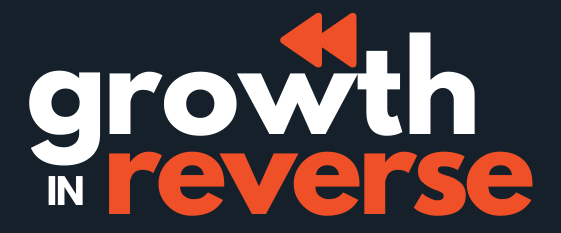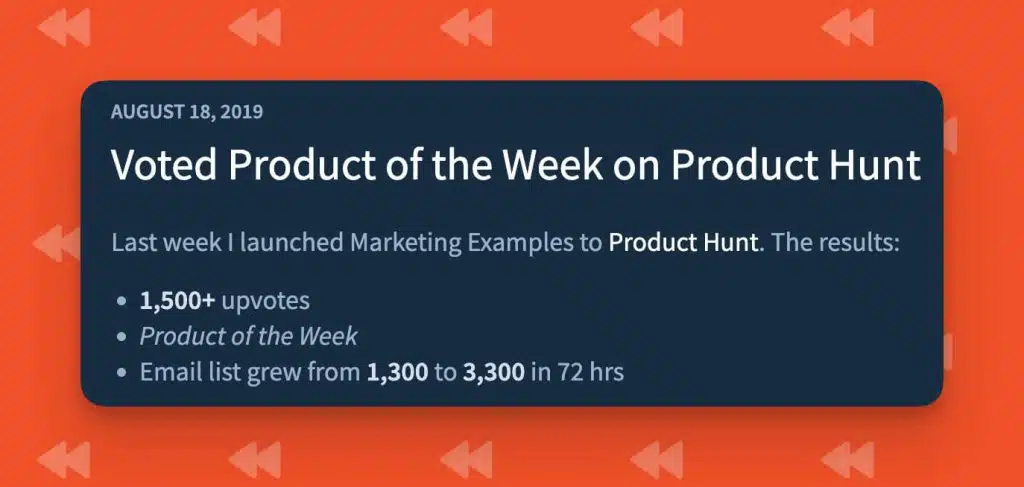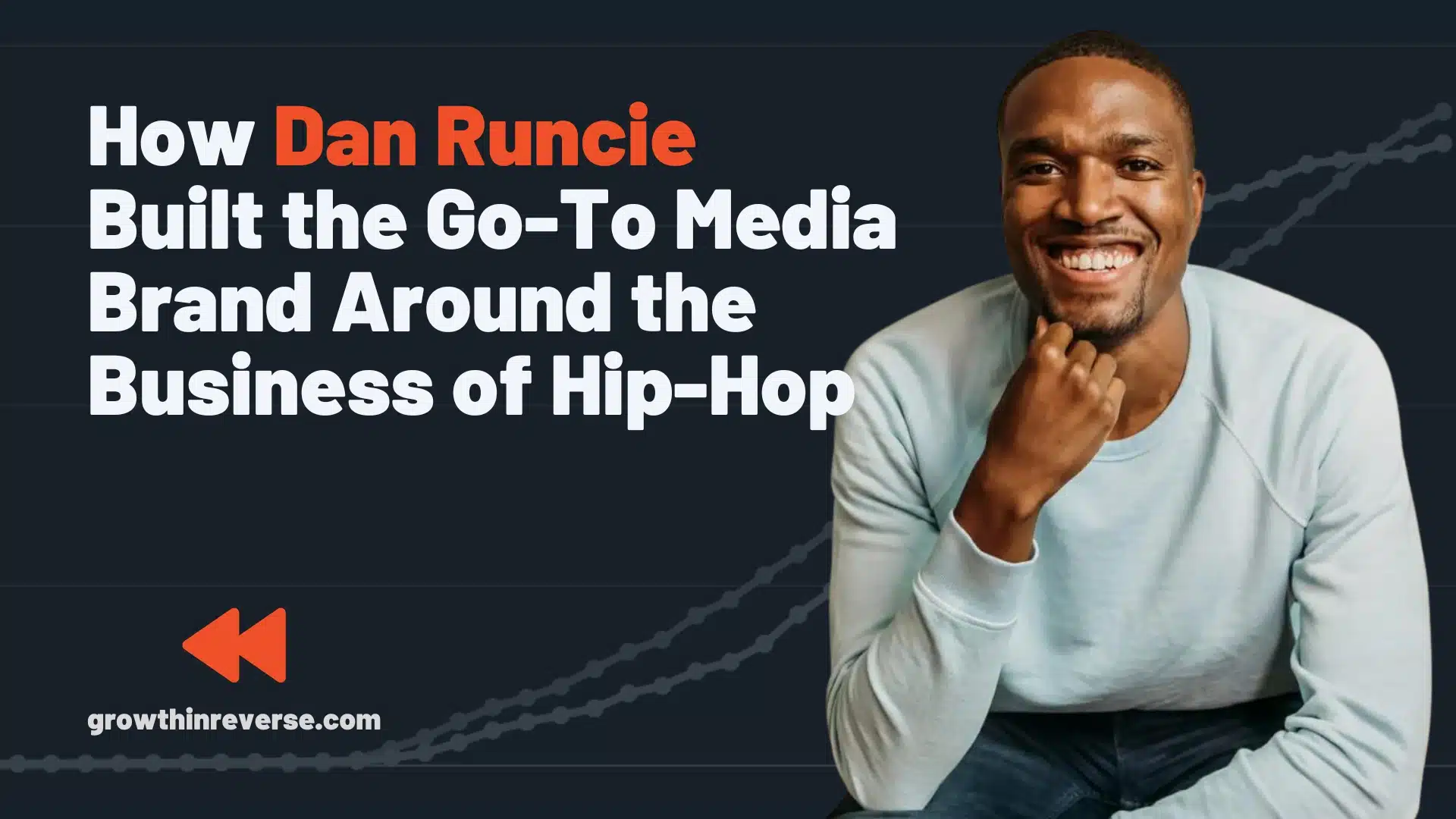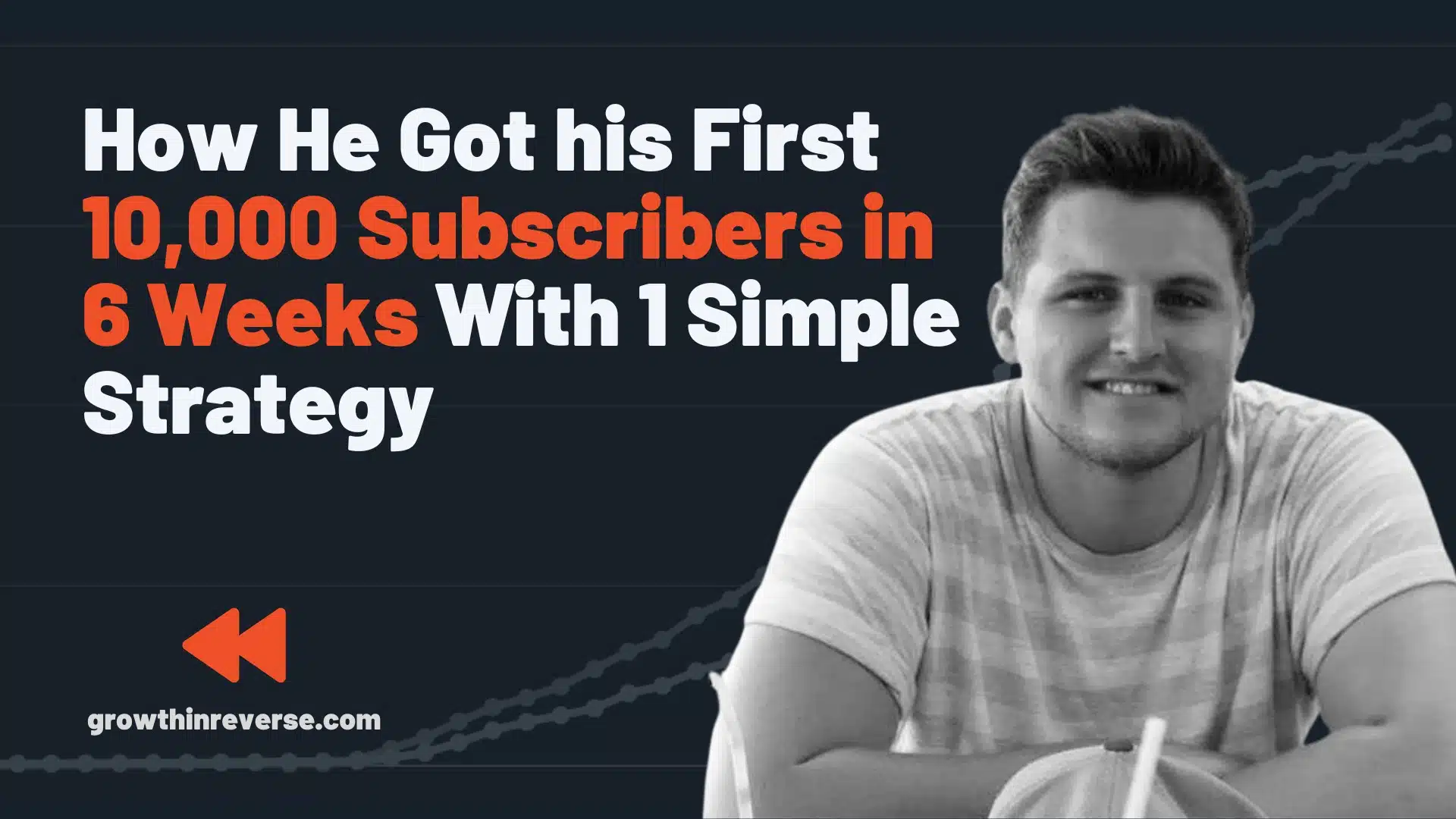Harry Dry, built his 130k-person newsletter audience in around 3.5 years, using some of the smartest content distribution strategies I’ve ever seen.
If you’ve been in the online space for a bit, you’ve probably heard of MarketingExamples.com.
The craziest part is that while it’s certainly not easy to do, it’s not even that complex.
And he didn’t even create anything new for 8 months in 2021, but his audience still kept growing.
I’m breaking down his full strategy and giving you the step-by-step plans to replicate it in this week’s deep dive.
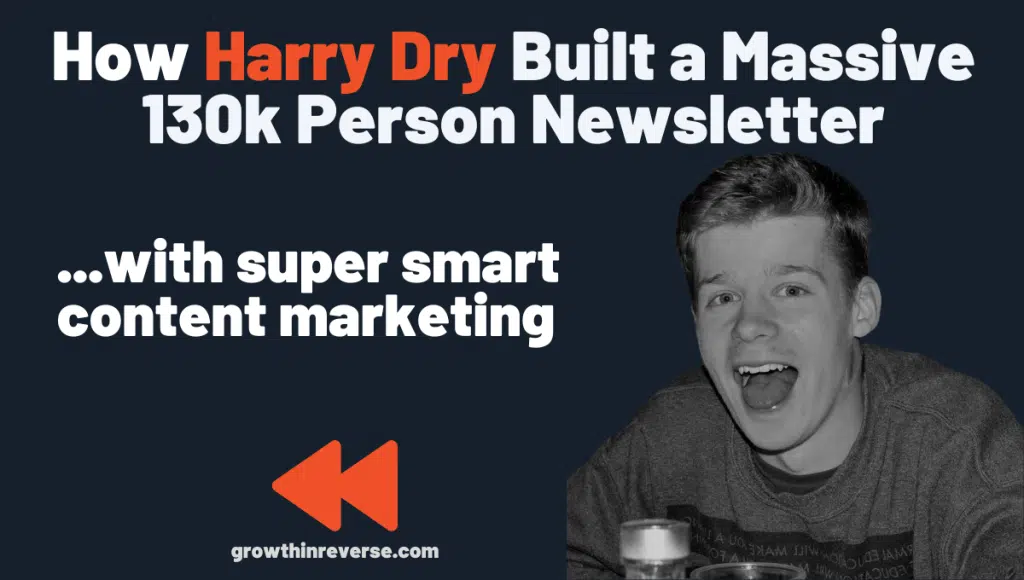
How Marketing Examples Makes Money
The Marketing Examples newsletter and website is, from what I can tell, solely making money from sponsorships at this point.
While Harry has hinted at a course being launched, so far I haven’t seen anything or heard about it since.
Sponsorships
Harry sells sponsorships to companies, but in a very different way. While most newsletters play the game of finding new sponsors every week, Harry gets sponsors to commit for months at a time.
For a while, he had Ahrefs, but lately, he’s been promoting SEMRush on his website.

He promotes them alongside his regular articles on the home page.
He also adds them to his emails for more visibility:

Other than that, Harry has hinted at creating a course about copywriting, something he’s been deeply studying since 2021.
In the beginning, he was charging only $2300 a month for a sponsor, but I’d have to hope he’s increased that since.
The Growth Timeline of Marketing Examples
Alright, let’s dive into the numbers.
I dug into Indie Hackers, Twitter, Reddit, Facebook groups and a LOT of podcasts to come up with this data.

The First 50k Subscribers
That chart is wild. Aside from TLDR, I think this is the most consistent growth we’ve seen in these Deep Dives.
Let’s break it down a little further and look at the road to 50k subscribers for Marketing Examples.

Product Hunt Launch
In August 2019, 4 months after launching MarketingExamples.com, Harry launched on Product Hunt.
Here were the results:
Using some of the data from some past deep dives, I almost wonder if he should have waited another month or two, and maybe gotten around 3-4k subscribers instead of 2k.
Now, 2,000 subscribers are nothing to sneeze at, but with some more support behind the launch, it might have been much better.
Dru Riley waited until he had around 3k email subscribers to launch. Ali Abouelatta did the same with First 1000.
Okay, let’s move on to how Harry was able to grow his email list so quickly.
The 3 Growth Levers of Marketing Examples
Three things stood out to me as I was doing this research, and why I think he’s had so much success.
🧪 1. Conversion optimization. Harry is a huge proponent of optimizing your copy, forms, and landing pages to get the most out of the traffic you’re already getting.
🔄 2. Growth Loops. What’s a growth loop, you ask? Great question. The way Harry interacts and links his digital properties together is super smart. And it leads to growth all over the place.
⚙️ 3. Building a distribution machine. It might seem odd that I’d add promotion/distribution to this list, but Harry is a master at this. I’ve included a step-by-step walkthrough for you.
Let’s break down each one of those and see why they worked.
🧪 1. Conversion Rate Optimization
I consumed a LOT of information in doing this research. On every single podcast or interview, Harry brings up conversion rate optimization.
And for good reason.
It’s a heck of a lot easier to improve your conversion rate than it is to get more traffic.
For example, let’s say you want 100 email subscribers each month.
Your page converts at 1% and you get 5,000 people to that page every month.
To improve your numbers from 50 to 100 subscribers, you can either increase traffic or increase your conversion rate:
By increasing your conversion rate from 1 to 2%, you can reach your goal without having to go out searching for new traffic methods.
To get the same returns by increasing traffic, you’d have to double your traffic, going from 5,000 to 10,000 people on your site every month.
That’s very hard to do, especially up front.
So how can you improve your conversions?
Give people multiple options to sign up
One of the ways Harry has improved his conversion rate quite a bit is by adding more ways for people to sign up.

He has a dedicated page aimed at getting people to subscribe that he uses when he links to his site from a Twitter thread, or a Reddit article. This is a page that is entirely focused on getting someone to subscribe.
He said that by the time they click that link, they’re already sold on Marketing Examples, so why would he make it hard for them and send them to the generic homepage?
Make it easy for people to subscribe. No one should ever be searching for a way to join your newsletter.
If you end up on a different page, he has 4 other ways to get people to sign up there also:
1. Navigation bar at the top where you can enter your email and subscribe.
2. Sidebar clickable image that links to the overlay you see above.

3. At the end of many articles, he asks people to subscribe.
4. A pop-up that appears if you’ve been on the website for more than 60 seconds
Love them or hate them, his pop-ups are wildly effective. To the tune of around 50% of his subscribers have joined his list from them.
Think about that. If he had just not tried a pop-up, his list would be HALF the size it is today.
And he’s doing it tastefully. He’s not loading the pop-up 5 seconds after you’ve been on the page. He makes sure you’re really interested before asking if you want to subscribe.
Here is a breakdown from one of his articles showing the percentages of where people opted into his email from.
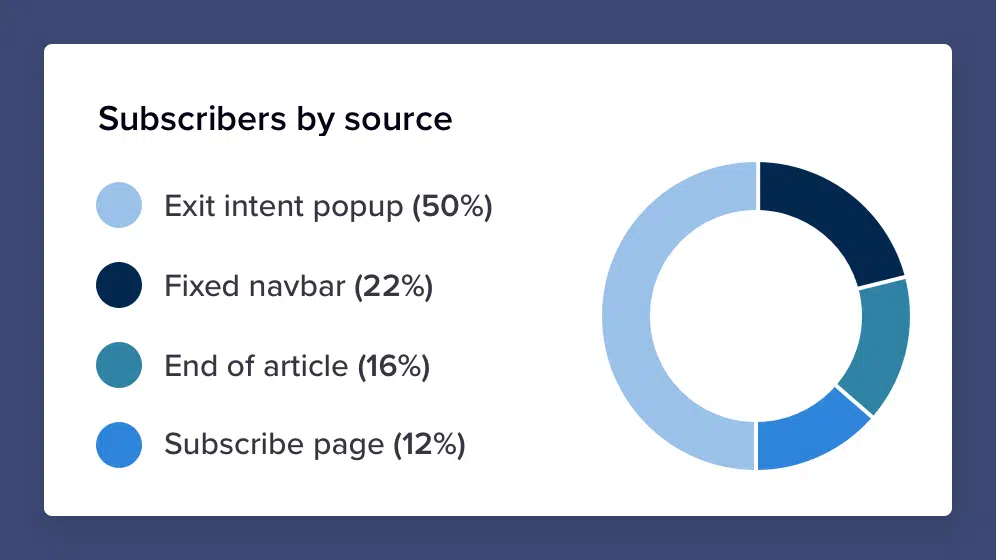
Improve the copy on your landing pages and forms
Harry is big into copywriting, but in the beginning, his forms were a bit lackluster.

On the left, he has really boring copy – and it wasn’t converting very well.
Today, it’s punchy and shows off his personality.
A few things he’s improved over time that you can use:
- He includes his name and a real picture of himself
- He tells you exactly what you’re going to get
- He tells you when you’re going to get it
- He includes social proof with both the number of subscribers and a bunch of testimonials. On the current form, you can scroll down a lot and see a wide variety of compliments from readers.
- He calls out “marketers” as the main segment of his audience that reads the newsletter
- Instead of the boring “subscribe” button, he uses “Try It”
🔄 2. Growth Loops
Are you ready for the gold of this post?
The growth loops concept I’m about to share with you is so simple, but so genius.
And it goes against a lot of marketing advice you might have heard in the past.
Instead of trying to keep people on his website only, he tries to get them moving around multiple platforms.
So he creates what he calls “growth loops”. I think of it like an ecosystem.
Instead of just keeping people on the website, he knows that his Twitter profile is a main driver for subscribers and it’s a place to build a deeper relationship with his audience.
So at the end of his emails (since that person is already subscribed), he asks people to like his thread about that post they just read.
While the ultimate goal is to get people on his email list, he doesn’t shy away from sending those people back to Twitter to help spread the word.
I think a lot of the “conventional,” marketing wisdom is, oh, keep people on your website, keep people on your website, but I just think that’s old advice.
Harry Dry
Let’s look at an example.
What Most People Do
Here is what most people trying to grow a newsletter (or website) will do:
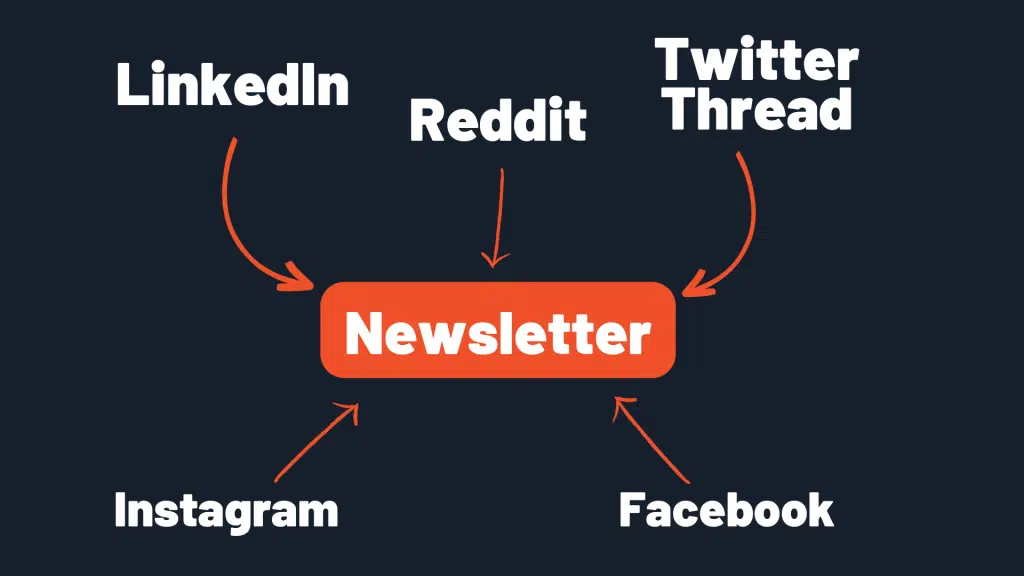
They send everything to their website or newsletter. Maybe they have share buttons or social icons on their site, but it’s not a priority.
Harry does this differently.
How Harry Thinks About Content Marketing
Here is an example of what he does for Twitter.
You can swap out the Twitter part if you have a bigger following on another platform, this is just an example of how it would work. You could do the same with LinkedIn, TikTok, etc.

He doesn’t just post a Twitter thread – he then links to it from his newsletter and embeds it into the article.
These people are already on his list, and they’re enjoying the content. Why not go for a small ask of liking the thread?
Why Does This Simple Shift Matter?
Promoting his Twitter thread it gives that post a boost of engagement, signaling to the algorithm that these are valuable. More people share it, and more new people see it.
When more people see his Twitter posts, this gets him more followers.
As those followers see more and more of his content, a percentage of them will subscribe to the newsletter.
Most people just send everything back to their newsletter, and they miss out on this additional layer of traffic.
It’s a big growth loop.
And it’s so obvious that he’s successful with this strategy.
If you look back at the growth timeline, you can see that as his Twitter is growing, his newsletter is growing at the same rate.

Compare that to other people that have huge Twitter followings, but only a very small percentage of email subscribers.
Their channels are growing separately from one another because they’re only sending people to the newsletter and not back to Twitter to engage with their posts.
I can only imagine if they implemented something similar to this.
See what I meant by it’s so simple but so genius?
He thinks about all of his channels as one. While the newsletter is most important, a rising tide lifts all boats, so he’s willing to grow his other channels knowing they will come to his website eventually.
⚙️ 3. Build a Distribution Machine
Harry doesn’t stop there, his distribution is next level as well. I haven’t seen many (if any) people putting in the same level of effort in such a methodical way.
Sure, we all know we need to be promoting the content we spend so much time on. There’s no shortage of quotes about spending 80% of your time on marketing and 20% on creation.
But Harry Dry lives this with every new article.
It honestly made me feel like a complete slacker when I saw how he did this. He breaks it down too in his post about sharing content.

Every time Harry publishes an article, he promotes it in multiple places:
- Twitter thread
- Twitter post
- 5 Facebook groups
- 5 Slack groups
- Multiple Reddit communities
- Indie Hackers
- Hacker News
- Other communities that are relevant
He’s not just spamming links to his new articles either.
He natively posts on each platform. While it might take a bit more time, his results are incredible.
Let’s break down each platform and how he utilized them.
But the best part is, he starts promoting the article before it’s even written.
Pre-Publish
When Harry is about 80% of the way done with an article, he’ll start promoting it. Yes, before it’s even complete.
He takes one of the better examples out of his full article and publishes that on Twitter.
Then he has a list of around 20-30 Facebook groups you can share marketing content with. He’ll pick the relevant ones, and publishes that quick tip to those groups.
Many Facebook groups look down on self-promotion (i.e. sharing your own links), so he does something really smart and just shares the tip with little callouts in the corner of the image.

He knows the content is good enough that people are going to want to find more of his stuff.
If the group is really not okay with self-promotion, he publishes these tips without these callouts on the image.
They’ll click his profile, and find his website that way.
He then goes on to post that tip on Indie Hackers, LinkedIn, and Reddit as well.
Why Does This Work?
By teasing out the best tip from the article, he’s getting people framed for the content. Once the full article is published, people are already going to be intrigued to read the rest of the post.
He’s building in a little layer of hype before the articles goes live.
Twitter Threads
Harry used Twitter threads really effectively in his promotion strategy.
As soon as he would publish an article, he posts a Twitter thread. Immediately.
And as soon as he hit publish on the Twitter thread, he embeds a link to the thread in his email and an email to his newsletter.
He said in one interview that he would essentially rush around trying to do everything quickly so he could leverage his email audience to promote the Twitter thread.
Again, all of this fuels his growth loops (see the last section).
And at the end of the thread, he links back to that article and the newsletter.
Of course, most creators do the last part, without being so intentional with the timing.
Slack Groups
He’s also careful not to self-promote on Slack too.
Here is a post he put in the “PPC” channel of an online marketing Slack group:

But then in the “Shameless Self Promotion” channel, he’ll be a little more liberal and will include links to his website.

Of course, he spent time becoming an active member in all of these groups before posting his own content.
That’s a critical step, especially since you might be blurring the lines of what’s allowed.
While Slack groups might not be as relevant for you, this same concept and strategy can work in other places like Telegram or Discord.
Lots of people (including myself) are scared to post on Reddit because you hear of posts getting taken down and the community being so against self-promotion.
But Harry decided to just try it out and figure out what he could do.
He admittedly said that he’s had posts taken down and gotten yelled at for self-promotion, but if you do this correctly you can get a lot of traffic.
He’s not afraid to fail so that he can learn.
Some subreddits are more lenient on self-promotion as long as you give value first.
This Reddit post from Harry is essentially the entire article copied from his website. It’s valuable, and a great story.
At the very end (and nowhere before), he plugs his newsletter. It got 124 comments on just that one subreddit and probably hundreds if not thousands of visitors to his website.

He also reshared this exact post in other subreddits and had success there as well.
He’s also used this strategy and shared some of the quick tip images, listicles of 36 copywriting tips, etc. on Reddit.
A Recap of Harry’s Distribution Strategy
That was a lot, so let me break it down a little more simply now that you understand why this all works.
When the article is about 80% done:
- Post one of the best tips from the article on Twitter with an image
- Post that same tip on LinkedIn
- Publish it to 15-20 Facebook groups
- Post it in 5-10 Slack groups
- Post the tip on Instagram
- Publish the tip on Indie Hackers
Yes, that’s all before the article is even done.
Now you have the attention of people, and when you actually publish the full article, it’s going to get some more buzz because people are excited about that teaser.
Once the article is published:
- Post a full Twitter thread
- Link to the article
- Link to the email newsletter
- Embed the thread at the bottom of the article on your site
- Send the article to your newsletter with the link to the Twitter thread asking them to share
- For really good articles, he asks people to spend 15 seconds to like the thread
- Publish the thread as a carousel on LinkedIn
- Publish the post on Reddit
- Publish an Instagram Carousel
- Publish on Indie Hackers
Quick caveat: all of these mentions of “Twitter” can be replaced with “LinkedIn” if that’s the platform you have more traction on. Don’t send the link to the Twitter thread if you’d get much more reaction on LinkedIn.
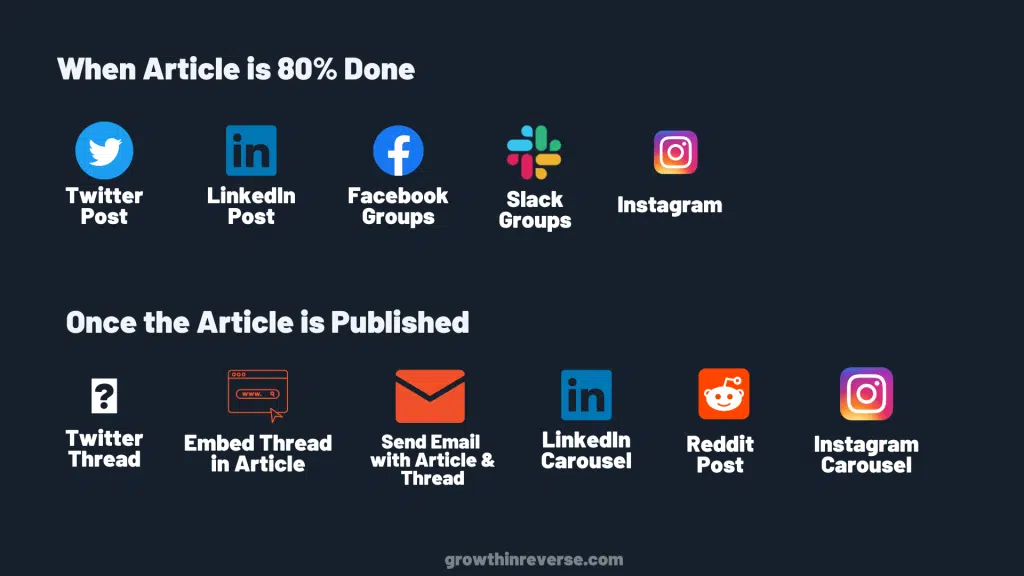
Of course, you can add other channels like TikTok and YouTube Shorts and a full video if you’re into video. The background behind this concept is the same, but the platforms might vary.
The Results
Here is a breakdown Harry created about where his subscribers come from across social platforms.
This was posted when he had around 19k subscribers, but I imagine these results would have just compounded as he kept at it.
There is so much intentionality with this strategy, Harry deserves every ounce of growth he’s seen from these methods.
People Are Becoming Immune to “Regular” Marketing
People can smell marketing miles away at this point.
The lazy way is to just spam your links around and end up pissing off community leaders and the people reading your post.
But if you give a lot of value first, then you can plug your newsletter or the article in question if it makes sense.
It kind of reminds me of how customer service has been going down the tubes lately. 2020 accelerated it but I think it’s been happening for a while.
We’ve come to expect crappy service anymore.
If your restaurant waitstaff is just nice and does its job correctly, you stand out.
And I think the same goes for marketing.
When you take the time to actually give value to people, in the context of the community they are in, you stand out.
Here’s the story in a tweet thread:
